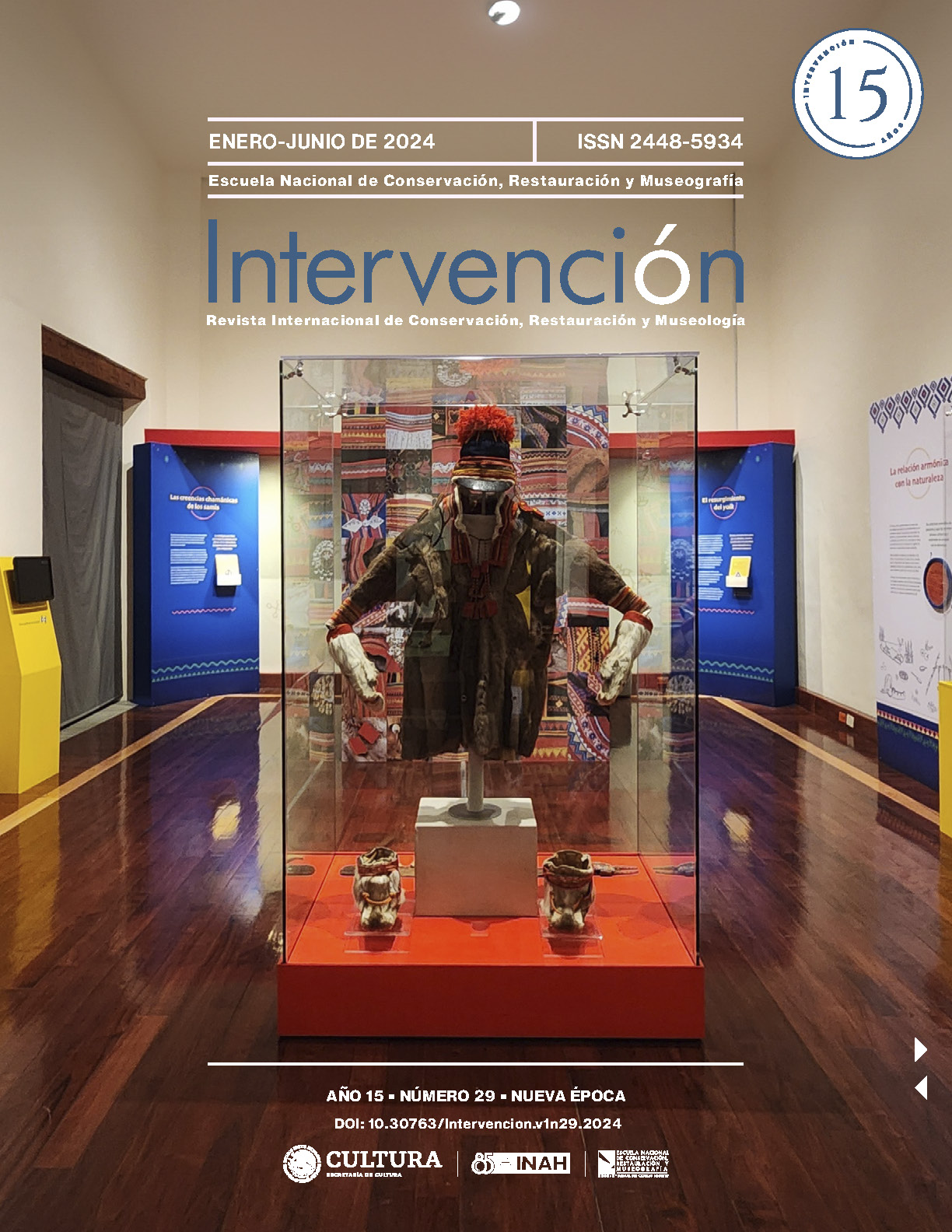Anoxic Treatment for the Eradication of Insects in the Choral Books of the Museo del Convento de los Descalzos, Lima, Peru
Published 2025-01-28
Keywords
- inert environment,
- disinfestation,
- anoxia,
- choir books
Copyright (c) 2024 Instituto Nacional de Antropología e Historia (INAH)

This work is licensed under a Creative Commons Attribution-NonCommercial 4.0 International License.
How to Cite
Abstract
One of the main causes of the loss of historical heritage in museums is insect attacks. At the Museo del Convento de los Descalzos in Lima, Peru, this is a severe problem, particularly in its choral books, which date from the 17th to 19th centuries, due to the materials used in their manufacture. Some disinfestation treatments for objects require compounds that either damage them or are toxic. A non-aggressive and effective alternative to disinfestation is anoxic treatment. In this case, the books were placed in laminated aluminum bags filled with nitrogen and an oxygen inhibitor. The treatment's efficiency was confirmed through X-ray images of the books. This inexpensive and easily adaptable disinfestation method was successful and constitutes a noteworthy way to stop the deterioration caused by xylophagous infestation, both of choral books and other objects of artistic and historical value.
Downloads
References
- Bueno-Vargas, J. (2006). Deterioro en encuadernaciones manuscritas de gran formato: Causas intrínsecas de alteración en los libros de coro. Cuadernos de Restauración, 6, 43-56. https://idus.us.es/handle/11441/49932
- Chidichimo, G., Dalena, F. y Beneduci, A. (2015). Woodworm Disinfestation of Wooden Artifacts by Vacuum Techniques. Conservation Science in Cultural Heritage, 15, 267-280. https://doi.org/10.6092/issn.1973-9494/6179
- Chidichimo, G., Dalena, F., Rizza, A. y Beneduci, A. (2017). Insect-Infested Wood Remediation by Microwave Heating and Its Effects on Wood Dehydration: A Case Study of Hylotrupes bajulus Larva. Studies in Conservation, 63, 97-103. https://doi.org/10.1080/00393630.2017.1314584
- Crespo, L. (2014). Libros de coro: naturaleza y conservación. En Cantora-les. Libros de música litúrgica en la BNE (pp. 91-110). Biblioteca Nacional de España. https://www.bne.es/es/publicaciones/cantorales
- Estrela, C. (2015). Estudio técnico y del estado de conservación de un libro litúrgico de gran formato (cantoral) del Real Monasterio de Santo Espíritu del Monte, Gilet. Estrategias para su conservación (Tesis de grado en Conservación y Restauración de Bienes Culturales). Facultad de Bellas Artes de San Carlos. Universidad Politécnica de Valencia. https://riunet.upv.es/handle/10251/52540
- García, J. A. (2005). Los libros corales de la Catedral de Cádiz. Historia. Instituciones. Documentos, 32, 145-174. https://revistascientificas.us.es/index.php/HID/article/view/4954
- Hanlon, G., Daniel, V., Ravenel, N. y Maekawa, S. (1993). Dynamic system for nitrogen anoxia of large museum objects: A pest eradication case study. AIC Annual Meetings. https://wag-aic.org/1993/WAG_93_hanlon. pdf
- Lauder, D. y Pinniger, D. (2019). Freezing guidelines for controlling an insect pest infestation. Consultado el 5 de septiembre de 2023. https://www.english-heritage.org.uk/siteassets/home/learn/conservation/collec-tions-advice--guidance/freezing-guidelines-for-controlling-insect-pest-in-festation.pdf
- Lewis, V. R. y Haverty, M. I. (1996). Evaluation of Six Techniques for Control of the Western Drywood Termite (Isoptera: Kalotermitidae) in Structures. Journal of Economic Entomology, 89, 922-934. https://doi.org/10.1093/jee/89.4.922
- Linnie, M. J. y Keatinge, M. J. (2000). Pest control in museums: toxicity of para-dichlorobenzene, ‘Vapona’™, and naphthalene against all stages in the life-cycle of museum pests, Dermestes maculatus Degeer, and Anthrenus verbasci (L.) (Coleoptera: Dermestidae). International Biodeterioration & Biodegradation, 45(1-2), 1-13. https://doi.org/10.1016/S0964-8305(00)00034-2
- Museums & Galleries of NSW. (2011). Managing pests in the collection: Integrated Pest Management (IPM). Community Museums Program. New South Wales Government. https://mgnsw.org.au/sector/resources/on-line-resources/collection-care/managing-pests-collection/
- Querner, P. (2015). Insect Pests and Integrated Pest Management in Museums, Libraries and Historic Buildings. Insects, 6(2), 595-607. https://doi. org/10.3390/insects6020595
- Rust, M. K. y Kennedy, J. M. (marzo de 1993). The Feasibility of Using Modified Atmospheres to Control Insect Pests in Museums. GCI Scientific Program Reports. Dept. of Entomology, University of California, Riverside/Getty Conservation Institute. http://hdl.handle.net/10020/gci_pubs/mod-ified_atmospheres
- Selwitz, C. y Maekawa, S. (1998). Preface. En Research in conservation: Inert gases in the control of museum insect pests (pp. xi-xiv). The Getty Conservation Institute. https://www.getty.edu/conservation/publications_ resources/pdf_publications/inert_gases.html
- Sierra, J. (2014). Los libros corales. En Cantorales. Libros de música li-túrgica en la BNE (pp. 43-64). Biblioteca Nacional de España. https://www. bne.es/es/publicaciones/cantorales
- Trematerra, P. y Pinniger, D. (2018). Museum Pests–Cultural Heritage Pests. En Christos G. Athanassiou y Frank H. Arthur (Eds.). Recent Advances in Stored Product Protection (pp. 229-260). Springer. https://doi. org/10.1007/978-3-662-56125-6_11
- Valentín, N. (1998). Preservation of Historic Materials by Using Inert Gases for Biodeterioration Control. En Shin Maekawa (Ed.). Oxygen-Free Muse-um Cases, cap. 3, (pp. 17-30). The Getty Conservation Institute. https://www.getty.edu/publications/resources/virtuallibrary/0892365293.pdf
- Zhang, B. (2012). Study on the Efficacy of Freezing Against Museum Pest Insect Demestes maculates. Current Research Journal of Biological Sciences, 4(3): 333-336. https://maxwellsci.com/print/crjbs/v4-333-336.pdf


